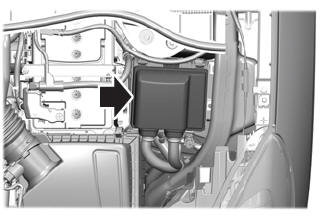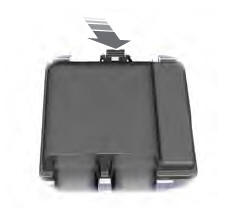Ford Escape 2020-2025 Service Manual / Electrical / Climate Control System / Supplemental Climate Control / Removal and Installation - Cabin Heater Coolant Diverter Valve
Ford Escape: Supplemental Climate Control / Removal and Installation - Cabin Heater Coolant Diverter Valve
Special Tool(s) / General Equipment
| Hose Clamp Remover/Installer |
Removal
NOTE: Removal steps in this procedure may contain installation details.
-
Remove the front bumper cover.
Refer to: Front Bumper Cover (501-19 Bumpers, Removal and Installation).
-
.jpg)
.jpg)
Loosen the pressure relief cap..jpg) WARNING:
When releasing the cooling system pressure, cover
the coolant expansion tank cap with a thick cloth to prevent the
possibility of scalding. Failure to follow this instruction may result
in personal injury.
WARNING:
When releasing the cooling system pressure, cover
the coolant expansion tank cap with a thick cloth to prevent the
possibility of scalding. Failure to follow this instruction may result
in personal injury.
.jpg) |
-
Disconnect the coolant control valve electrical connector.
.jpg) |
-
Clamp off the coolant control valve hoses.
.jpg) |
-
Release the clamps and disconnect the coolant hoses.
Use the General Equipment: Hose Clamp Remover/Installer
.jpg) |
-
Remove the nuts and the transmission fluid cooler control valve.
Torque: 93 lb.in (10.5 Nm)
.jpg) |
Installation
-
To install, reverse the removal procedure.
-
Fill and bleed the cooling system without using a vacuum cooling system filler.
Refer to: Engine Cooling System Draining, Vacuum Filling and Bleeding (303-03C Engine Cooling, General Procedures).
 Removal and Installation - Cabin Heater Coolant Pump
Removal and Installation - Cabin Heater Coolant Pump
Special Tool(s) /
General Equipment
Hose Clamp(s)
Removal
NOTE:
Removal steps in this procedure may contain installation details.
Remove the front bumper cover...
 Removal and Installation - Cabin Heater Coolant Temperature Sensor
Removal and Installation - Cabin Heater Coolant Temperature Sensor
Special Tool(s) /
General Equipment
Hose Clamp(s)
Removal
NOTE:
Removal steps in this procedure may contain installation details.
Remove the RH fender splash shield...
Other information:
Ford Escape 2020-2025 Service Manual: Diagnosis and Testing - Body Control Module (BCM)
Diagnostic Trouble Code (DTC) Chart Diagnostics in this manual assume a certain skill level and knowledge of Ford-specific diagnostic practices. REFER to: Diagnostic Methods (100-00 General Information, Description and Operation). Module DTC Description Action BCM B11D8:01 Restraint Event Notification: General Electrical Failure GO to Pinpoint Test A BCM B153F:01 Power Di..
Ford Escape 2020-2025 Service Manual: Removal and Installation - Passenger Side Instrument Panel Speaker
Special Tool(s) / General Equipment Interior Trim Remover Removal Position the speaker and grille up as an assembly. Use the General Equipment: Interior Trim Remover Disconnect and remove the speaker and grille as an assembly. Release the tabs and remove the speaker. Installation T..
Categories
- Manuals Home
- 4th Generation Ford Escape Owners Manual
- 4th Generation Ford Escape Service Manual
- Adjusting the Headlamps
- Plug-In Hybrid Electric Vehicle Drive Modes
- Locating the Pre-Collision Assist Sensors
- New on site
- Most important about car
Under Hood Fuse Box
Locating the Under Hood Fuse Box

Accessing the Under Hood Fuse Box

Copyright © 2025 www.fordescape4.com
